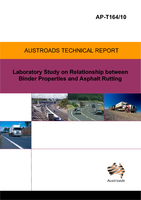Pavement

Laboratory Study on Relationships Between Binder Properties and Asphalt Rutting
- Publication no: AP-T164-10
- ISBN: 978-1-921709-34-0
- Published: 9 August 2010
- PDF (free) Download
A major study was undertaken to determine relationships between binder rheological properties and the rut resistance of asphalt mixes, as indicated by the laboratory wheel tracking test. Twelve binders, including three bitumens, a Multigrade binder and eight polymer modified binders (PMBs), typical of Australian production, were used. The binders were characterised using a number of procedures including the ARRB Elastometer test and the Dynamic Shear Rheometer (DSR). The objective of the study was to identify the most appropriate binder parameter for possible inclusion in a future version of the PMB specification framework.
- AP-T164-10 Laboratory Study on Relationship between Binder Properties and Asphalt Rutting
- Austroads profile
- Austroads membership
- CONTENTS
- TABLES
- FIGURES
- SUMMARY
- 1. INTRODUCTION
- 1.1. Background
- 1.2. Objectives
- 1.3. Test Program Overview
- 2. MATERIALS
- 2.1. Binders
- 2.2. Asphalt
- 3. LABORATORY TESTS
- 3.1. Wheel Tracking Test
- 3.2. Binder Tests
- 4. CONVENTIONAL BINDER TESTS
- 5. ELASTOMETER
- 5.1. Equipment Overview
- 5.2. Consistency and Elastic Recovery
- 5.3. Underlying Viscosity (UV)
- 5.4. Consistency Measured at Various Strains
- 6. SHRP G*/SIN
- 6.1. Conditioning of A35P and A30P Binders
- 7. ZERO SHEAR VISCOSITY (ZSV)
- 7.1. Extrapolation Methods
- 8. VISCOSITY MEASURED USING DSR
- 9. DATA ANALYSIS
- 9.1. Softening Point
- 9.2. Elastometer Parameters
- 9.3. Elastometer Parameters – Analysis
- 9.4. DSR Parameters
- 9.5. DSR Parameters – Analysis
- 10. SUMMARY, DISCUSSION AND CONCLUSIONS
- 10.1. Binder Property and Rut Resistance
- 10.2. Elastometer Testing Condition
- 10.3. Limitations of the Study
- 11. RECOMMENDATIONS
- REFERENCES
- INFORMATION RETRIEVAL
Related publications
WEB-R708-24
Latest Pavement News
